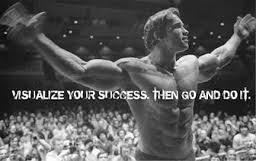Understand Imagery & Visualization
By Dr. Steve @SportsShrink with @MentalProgram
The power of imagination makes us infinite. ~ John Muir
Imagery is the process in which one is able to produce pictures or movies in the mind.
Visualization includes what you see (i.e., visual goals) and why to see it (i.e., the meaning and Intention) during the imagery process.

Investigations have identified that a positive correlation exists between an athlete’s caliber (i.e., his or her competitive level) and the amount of structured or regular imagery sessions he or she utilizes.
Research suggests value in using mastery-goal oriented imagery to build confidence, whereas arousal-based imagery facilitates arousal control and anxiety management.
10 Principles for implementing imagery techniques:
- Practice regularly
- Use all senses to enhance vividness
- Develop image control via repetition and concentration
- Use internal and external perspectives
- Use imagery in practice and competition
- Use video and/or audio as needed to enhance skills
- Use triggers or cues to facilitate quality
- Emphasize kinesthetic imagery
- Imagine in real time
- Create a schedule and keep record
Imagery Practice
Numerous research studies have found that top athletes used imagery for a vast array of reasons, including:
- Develop and execute skills and strategies
- Generate motivation related to performance and outcomes
- Facilitate skill acquisition and maintenance
- Regulate excitement, control, and relaxation
- Increase mentally toughness, focus, and confidence
- Achieve flow states
Imagery research has found that mental practice positively impacts learning and performance of motor skills thus enhancing athletic performance.
Research with Olympic athletes’ use of mental rehearsal, specifically imagery visualization reported that athletes primarily use mental practice strategies when retiring the night before the competition or even throughout the build-up to the event. Although, this tool can be used at any time such as upon awakening, before practice, and during idle time (e.g., waiting at the doctors office, on a plane ride, or traveling as a passenger).
Several studies found that the most successful performers visualize with higher quality. The degree to which an image is accurate also determines whether or not an athlete’s visualization will be effective.
Just Practice Imagery
Video Option – 8min
Advanced Imagery Skills
Define imagery ability by 1) the level of vividness and 2) controllability that athletes have over their visualizations.
- Vividness refers to the clarity and reality of an athlete’s image
- Controllability refers to the athlete’s ability to influence the content of the image
Kinesthetic imagery may also be viewed as a property of imagery. It involves the ability to visualize images, including the sensory ability to detect bodily position, weight, or movement of the muscles, tendons, and joints.
Studies have suggested that elite athletes had superior kinesthetic images compared to novice athletes.
The correctness of imagery includes 2 perspectives:
- Internal perspective (i.e., somatic experiencing of imagined sensations)
Viewing the event through your own eyes - External perspective (i.e., objectively observing a performance)
Viewing the event through a camera on your performance
Research suggest that an external-imagery perspective is effective for imagining tasks in which form is important, whereas an internal-imagery perspective is effective when visualizing open-skilled tasks* in which perception is important for performance.
*Open-skilled task: where little predictability of the environment exists.
Just Practice Imagery
Video Option – 10min







 sending...
sending...